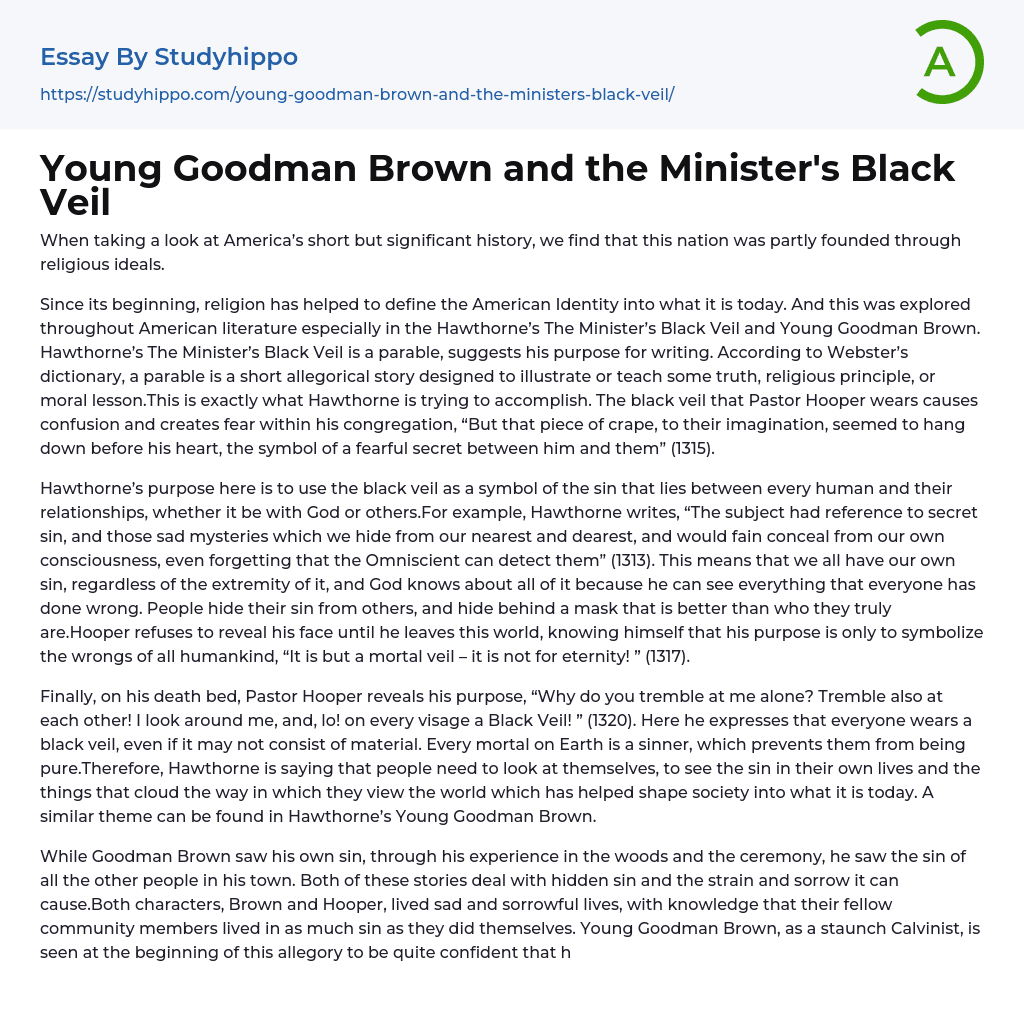

Young Goodman Brown and the Minister’s Black Veil Essay Example
The founding of America was influenced by religious principles, despite its brief existence in history.
Religion has played a significant role in shaping American identity, a theme explored in American literature such as Hawthorne's The Minister's Black Veil and Young Goodman Brown. Hawthorne's parabolic tale uses the symbol of a black veil worn by Pastor Hooper to illustrate a religious principle or moral lesson. This veil creates fear and confusion among his congregation, who perceive it as a symbol of secrecy between them and the pastor's heart (1315).
Hawthorne's goal is to use the black veil as a representation of the sin present in all human relationships, whether with God or others. Hawthorne explains that everyone has their own hidden sin, and even though it may not be severe, God is aware of it.
...People conceal their sin from others and wear a mask that does not reflect their true selves. Hooper decides not to reveal his face until he dies because he only intends to symbolize humanity's wrongdoings. He firmly believes that the veil is temporary and will not last forever.
Pastor Hooper finally reveals his purpose on his death bed by exclaiming, "Why do you tremble at me alone? Tremble also at each other! I look around me, and, lo! on every visage a Black Veil!" (1320). This statement conveys that all individuals don a black veil, even if it is not tangible. All humans are sinners, thus impeding their chance at purity. Hawthorne underscores the importance of self-reflection to recognize the sin that clouds our worldview, and how it shapes society. This theme resonates in his work, Young Goodman Brown
Through his experience in the woods and the ceremony, Goodman Brown came to witness not only his own sin but also the sin of all individuals in his town. The two stories share a theme of concealed sin and the negative emotions it brings about. Both characters, Hooper and Brown, lived unhappy lives, aware that their community members were just as sinful as they were. In this allegory, the devout Calvinist Brown is initially depicted as having a strong belief in his salvation.
The reason for his journey is shrouded in mystery, with many assuming it to be a deliberate mission to seek sin in the company of the devil. Whether this assumption holds merit or not, what's crucial is that he's intentionally meeting the devil on this outing. As the narrator states, his intentions are wicked. Despite this, Young Goodman Brown manages to retain his faith even after reaching his destination. His faith carries terrible and all-encompassing implications, which Hawthorne uses to critique Puritanic-Calvinist teachings. The story's message suggests that the doctrine of the elect and damned does not lead man to heaven as one might expect, but instead indiscriminately dooms them to hell. Very few can escape its consequences, making salvation near impossible.
Young Goodman Brown's understanding of his faith leads him to view his minister's teachings about "sacred truths" and future happiness or misery as blasphemy, as he has realized that according to his faith, he and his congregation are likely destined for "misery unutterable" (1298). This realization causes him to reject prayer and ultimately results in a lack of hope being etched onto his tombstone. The analysis of these stories shows Hawthorne's
critique of American identity, including the influence of Puritanism on his writing as well as his criticism of certain aspects of Puritan teachings. The flaws in American society, or our past, may be illuminated through this critique.
Hawthorne's "Goodman Brown" and "The Minister's Black Veil" illustrate how people in our society tend to be self-righteous and judgmental while ignoring their personal sins. Just like how everyone in Goodman Brown's community were sinners and Pastor Hooper hid behind his veil, many people continue to hide their true selves every day. According to Hooper on his deathbed, neither attending church nor acting righteous can erase past actions or remove the facade that people wear. Hawthorne's purpose is to convey that we all are sinners and should not judge others hastily. Rather, we should acknowledge our own faults without considering ourselves better or worse than anyone else.
The Norton Anthology of American Literature by W. contains a citation for Nathanial Hawthorne's "Young Goodman Brown." This information is enclosed within HTML paragraph tags.
"The Minister’s Black Veil" was written by Nathaniel Hawthorne and published in W. Norton & Company's 2007 edition, specifically on pages 1289-1298.
The text within the explains that the source of the information is a book titled "The Norton Anthology American Literature", which was published in New York by W. W. Norton & Company in 2007 and contains pages 1311-1320.
- Baptism essays
- Holy Spirit essays
- Jesus Christ essays
- Adam And Eve essays
- Crucifixion Of Jesus essays
- Crusades essays
- Eucharist essays
- God The Father essays
- Pope essays
- Protestantism essays
- Christian essays
- Church essays
- Elizabeth essays
- Sacrament essays
- Catholic Church essays
- Lord essays
- Priest essays
- Protestant Reformation essays
- Afterlife essays
- Atheism essays
- Bible essays
- Buddhism essays
- Christian Worldview essays
- Christianity essays
- Confession essays
- Cosmological Argument essays
- Deism essays
- Devil essays
- Existence of God essays
- Faith essays
- Freedom Of Religion essays
- God essays
- Hinduism essays
- Immortality essays
- Islam essays
- Jainism essays
- Jews essays
- Judaism essays
- Miracle essays
- Monk essays
- Monotheism essays
- New Testament essays
- Old Testament essays
- Pilgrimage essays
- Puritans essays
- Revelation essays
- Ritual essays
- Salvation essays
- Sin essays
- Sinners essays



